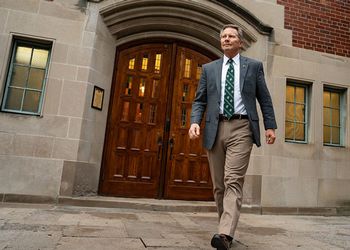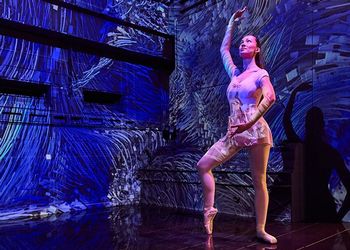Feature: Leading the Vanguard for Medical Reform

LEADING THE VANGUARD FOR MEDICAL REFORM
MSU's College of Osteopathic Medicine, the first ever established on a major campus, is pioneering important changes in medical education. Despite his quiet politesse, neatly tailored suits, and hand-written notes of appreciation, the dean of the MSU College of Osteopathic Medicine is a revolutionary at heart.
After one year at the helm, Douglas L. Wood, D.O., Ph.D., will unabashedly tell you that he is out to transform not only medical education, but American medicine itself, which he often characterizes as our 'disease care nonsystem.' His call for reform is echoed in newsrooms, board rooms, legislative cloakrooms and family dining rooms across the nation. Nearly 40 million Americans, for reasons either economic or geographic, are denied access to health care, and demand is dramatically increasing as our population grays.
The practice of medicine in the United States is entangled in cost-containment strategies, governmental regulations, malpractice issues, priorities of third-party payers and a multitude of special interests. Among laypersons and experts alike, the only agreement seems to be on the necessity for change. As Stephen M. Shortell notes, such reform requires 'a new kind of social contract -- a social contract based on paradox, ambiguity and change, risk, and the pursuit of' responsible excellence.'
Taking risks in the 'pursuit of responsible excellence' is a long-standing tradition for MSUCOM. The college was the first osteopathic institution on the campus of a major university, the first to be state-assisted, the first to work intimately with an M.D. school. Myron S. Magen, D.O., dean of the college from its inception until July 1991, is nationally recognized for his leadership in medical education, implementing two decades ago programs which are now being hailed as 'innovative' in other institutions. Among them are a curriculum built on the study of organ systems, early exposure of students to patients, emphasizing admission of nontraditional students, and clinical training in community settings.
In these early years, the college battled misperceptions about osteopathic medicine. Now osteopathic medicine has gained such acceptance that many believe it is in danger of losing its unique identity. But Wood views society as finally catching up to the values of the osteopathic profession, which celebrated its centennial this fall.
An emphasis on primary care, a person-centered approach that includes lifestyle and patient values, family- and community-oriented medicine, health promotion and disease prevention, appreciation for the relationships between body structure and function -- these are 100-year-old osteopathic concepts which have been touted only in the last decade as a 'modern' approach to medicine. The relatively small size of the osteopathic profession (about 5% of U.S. doctors), instead of being seen as a handicap, is fundamental to Wood's vision for change. 'Because we're small, we can be lean and mean,' he said. 'We can change course much more quickly. I believe it will be much easier to model medicine of the future in the osteopathic profession than it would be anywhere else.'
'Medical education is at a crossroads,' Wood said. 'It can continue to react to changes in medical practice, or it can be proactive and mold its own future. That future is up to us.'
Primary Medicine At a departmental retreat, MSUCOM pediatrics faculty sported T-shirts that read 'Primary care is the answer!' on the front, and 'What is the question?' on the back. The tongue-in-cheek attire reflects a keystone of the college's mission. 'I'm convinced that to meet the health care needs of the twenty-first century we must produce more generalists physicians,' Wood said. 'The ratio of specialists to generalists in this country is three to one. It should be one to three.'
Of MSU's 1,628 D.O. alumni, 62% are practicing primary care; the national average among medical schools is 30%. Wood's ambition, through a comprehensive Primary Medicine Initiative beginning in the college, is to raise that figure to 75%. Though many in government and health care are strongly supportive of stemming the tide of specialization, Wood is not planning to take medicine 'back to the future.' 'First and foremost, we are committed to the development of a new kind of physician,' Wood said. 'When they complete their residency, these doctors will have an unprecedented combination of breadth and scope of knowledge. That means they would handle the vast majority of health concerns for people of every age group in their communities, including many procedures which are only done by specialists today. When referral to a specialist is necessary, these new doctors would continue to coordinate the care for their patients.'
These new physicians, Wood noted, would be residency-trained in 'primary medicine,' a new concept being developed at MSUCOM which combines the best of general practice or family medicine, pediatrics, and general internal medicine. Weaving a Seamless Curriculum At present, traditional osteopathic medical education, after four years of college, includes four years of medical school, one year of a rotating internship, and one to four years of residency. Very often this education might occur in a number of schools or hospitals, all with different ways of teaching. To support the development of these new kinds of physicians, MSUCOM is developing a new curriculum for primary medicine, one that continues seamlessly through the completion of a primary medicine residency. This instruction would occur entirely under the auspices of the college, with the hope of eliminating duplication and streamlining (and very possibly shortening) training. This new curricular continuum would be supported at one end with a prematriculation program that would identify and nurture students with an interest in primary medicine, and at the other with a continuing medical education program that would enhance the primary medicine skills of practicing physicians.
While MSUCOM intends to model development of the primary medicine physician, there is no illusion that the college can singlehandedly change American medicine or medical education. Wood and his staff are building partnerships with individuals and institutions who can affect the practice environment -- state and federal legislators, health agencies, health institutions, physicians' associations, community organizations, patient advocacy groups, etc. 'A medical school can no longer take the paternalistic approach that says `we have all the answers,'' Wood stressed. 'It is our hope to develop and model a system of collaboration with those of similar commitment. 'In parallel, we are working to educate physicians who will take the same collaborative approach in meeting the health needs of their communities -- physicians who do not limit their practice to clinic or hospital, but who see themselves as positive agents of change to work with others to enhance health for all.'
The MSU College of Osteopathic Medicine:
- has graduated 1,628 alumni, 62 percent of whom are practicing primary medicine, and two-thirds of whom remain in Michigan. One-fourth of Michigan's D.O.s are MSUCOM graduates
- is the first state-assisted and university-based osteopathic college.
- enrolls more than 500 students; 38% are female, 17% are minority, 4% are economically disadvantaged.
- was the first to offer joint D.O./Ph.D. degrees in a Medical Scientist Training Program.
- provides more than 30% of the continuing medical education credits required for relicensure of Michigan D.O.s.
- provides graduate medical education for 35 interns and 60 residents



